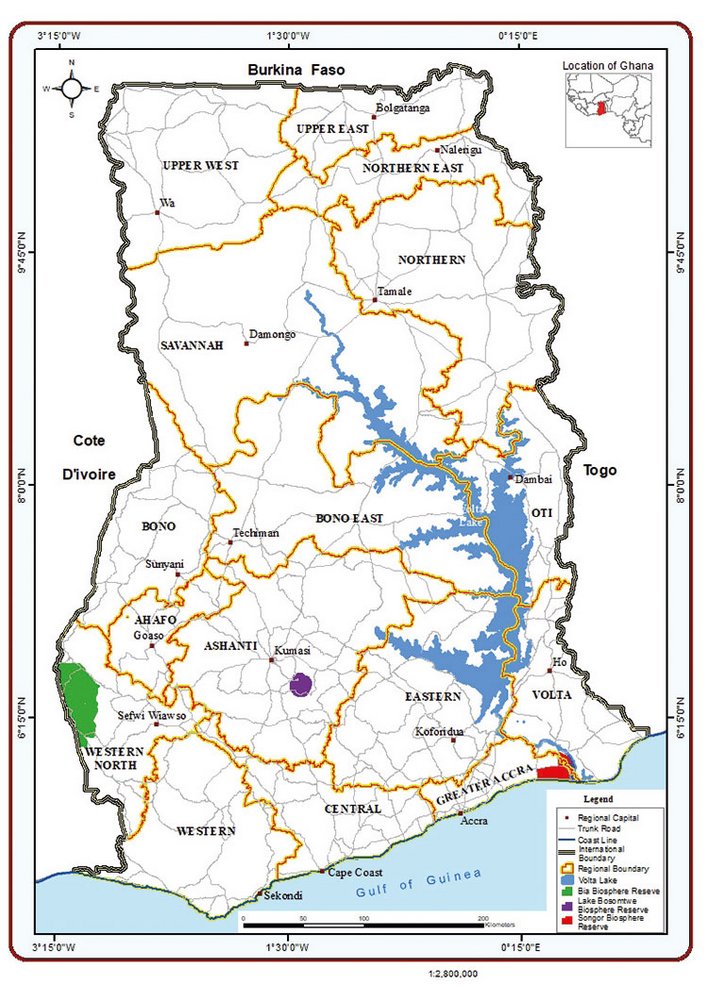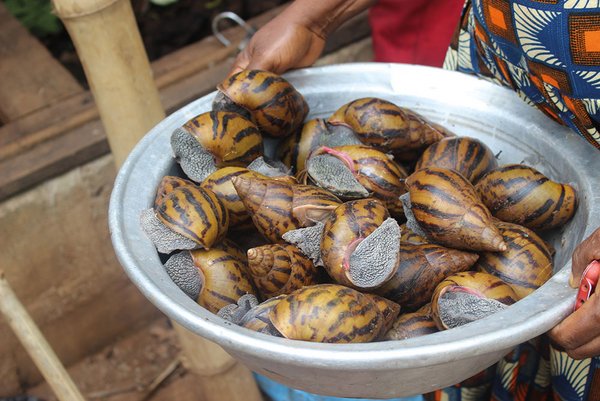Connecting people and nature – UNESCO biosphere reserves in Ghana
Local communities in Africa depend heavily on biodiversity for their livelihoods, such as subsistence agriculture, fishing, hunting and the extraction and processing of non-timber forest products like snails, honey and medicinal plants. Due to a higher population growth rate in such areas as compared to urban areas, there is a tendency to overexploit resources from forests, mountains, wetlands and other vital ecosystems to meet human needs without considering the ability of the natural resources to recover.
The introduction of protection regimes in many countries, especially in Africa, initially faced challenges with resource depletion and loss of biodiversity because it was often done without due consideration of local community needs, leading to animosity among individuals and communities, and between communities and authorities responsible for protected areas. Protection regimes must consider sustainable development principles, ensuring the establishment and maintenance of balance between conserving natural resources on the one hand and communities using these resources on the other, without compromising nature’s ability to sustain itself. Biosphere Reserves demonstrate this approach as a viable solution for a harmonic coexistence between human populations and nature.
One network, one vision, one world – UNESCO Biosphere Reserves
UNESCO Biosphere Reserves (BRs) are terrestrial or coastal sites that provide opportunities to reconcile the conservation of biodiversity with its sustainable use. They are designated by the United Nations Educational, Scientific and Cultural Organization (UNESCO) to model innovative approaches to attaining the Sustainable Development Goals (SDGs). The World Network of Biosphere Reserves (WNBR), introduced through the Man and the Biosphere Programme (MAB) 50 years ago, is an interactive and dynamic network that fosters the harmonious integration of people and nature. It combines various forms of knowledge, providing opportunities for joint learning across different sites in different countries and regions. The WNBR with a current membership of 714 sites in 129 countries, including 21 sites shared by two or more countries or continents, has been recognised as a major tool to be used for attaining the Sustainable Development Goals (SDGs). The biosphere reserve concept draws strength from its integration of diverse knowledge and diverse stakeholder networks and principles across several international conventions and programmes.
Biosphere reserves are designed to go beyond conserving biodiversity to address and place emphasis on community well-being. Hence, they serve three mutually reinforcing and equally important functions:
- conservation of genes, species, landscape, and cultural and ecosystem diversity;
- socio-economic development: providing essential benefits such as livelihoods, food and fodder, and cultural values to human communities;
- logistic support meaning research, monitoring and education.
To fulfil these functions, BRs are characterised by three interactive zones:
- the core area, which is strictly protected from all human activity except for research;
- the buffer zone, where human activity which is compatible with conservation goals is allowed, such as research laboratories;
- the outermost transition area, where communities live and benefit from the resources while ensuring sustainable practices.
BRs differ from other nature reserves based on the emphasis they place on human welfare as compared to previous ways of conserving resources that did not adequately consider community needs. The participatory approach is used in BRs to foster community empowerment to support conservation. Also, they provide opportunities for different stakeholders to combine knowledge for innovation and to learn sustainable development together.
Biosphere reserves facilitate the orientation or reorientation of stakeholders towards nature conservation with and through people and are emulated in many nature reserves. By combining all knowledge sources and bringing on board diverse stakeholder groups, management problems have been resolved more expediently. The joint learning and experiential sharing within the WNBR and its sub-networks have enhanced the capacities of local populations and their stakeholders through exchanges, educational programmes for children and youth, implementation of community initiatives to sustainable development and the integration of traditional knowledge concepts into conservation. Local populations are able to interact with their counterparts in other regions managing similar or different resources to learn from their experiences and seek common solutions. BRs also promote peace between populations in different countries through joint plans and programmes used to manage shared ecosystems.
Ghana’s story so far: the example of Bia Biosphere Reserve
Bia Biosphere Reserve lies in Ghana’s transition zone between the moist evergreen and moist semi-deciduous forest in the country’s southwest, along the border with la Côte d’Ivoire (see Map on page 22). The core area is made up of the Bia Conservation Area (Bia National Park and Bia Resource Reserve) and the “Apaaso” sacred grove, which is a sacred site visited only for prayers and sacrifice. The buffer zone is made up of degraded neighbouring forest reserves organised into community resource management areas and some communities, while the transition area comprises about 30 communities. The reserve is estimated to have a total population of 65,000, with about half living below the national daily minimum wage of 2 USD. It is managed by the Wildlife Division of the Forestry Commission in collaboration with the Community Resource Management Area (CREMA) committees and the Advisory Board. Communities are known to embrace the CREMAs because responsibility for management of the resources is devolved to them by the Wildlife Division, thereby increasing their sense of ownership.
The Bia BR is known to have some of the country’s tallest trees, such as Pericopsis elata and Khaya anthotheca. It also serves as a refuge for many important animal species. These include 34 species of mammals such as the African elephant (Loxodonta africana), chimpanzee (Pan troglodytes verus), olive colobus monkey (Procolobus verus) and Geoffroy’s Pied Colobus (Colobus vellerosus). There are also 60 species of birds such as the common bulbul (Pycnonotus barbatus) and the great white heron (Egretta alba), invertebrates like the giant African snail (Achatina achatina) and 40 species of Pericopsis elata butterflies including the citrus swallowtail (Papilio demodocus). Protecting these species contributes to achieving SDGs 13, 14 and 15.
GHANA'S BIOSPHERE RESERVES
Bia Conservation Area, a national park enlisted in 1983
Songor Ramsar Site, a coastal wetland enlisted in 2011
Lake Bosomtwe, a natural lake in Ghana enlisted in 2016
In terms of fulfilling the development function (SDGs 1, 2 and 3), communities are engaged in agriculture (chiefly cocoa, Ghana’s main cash crop), vegetable, fruit and other food crop farming, while some revenue is also generated from tourist visits to the national park and trading. The forest provides numerous medicinal plants used by the communities.
Several initiatives have been implemented by various stakeholders to address previous community animosity and perception of marginalisation relating to delineation of the national park. Two such initiatives emulating the benefits derived from being a part of the WNBR for Bia BR are UNESCO’s “Biosphere Reserves for Biodiversity Conservation and Sustainable Development in Anglophone Africa” (BRAAF) project, implemented in five forest ecosystems in Ghana, Nigeria, Tanzania, Kenya and Uganda from 1995 to 1997, and “Green Economy in Biosphere Reserve” (GEBR) project, implemented from 2013 to 2017 in three forest ecosystems in Ghana, Nigeria and Tanzania. Through the BRAAF project, communities were reoriented through capacity building, sensitisation and supplementary livelihood initiatives like snail farming, oyster mushroom production, grasscutter rearing and bee keeping to understand and support conservation. Recommendations were also made for creating a shared elephant migration corridor with la CÔte d’Ivoire. The GEBR project built on this foundation to reduce poverty by diversifying the local economy through beekeeping, mushroom rearing, palm oil production, business management and snail rearing (with 220 persons trained and set up in business). The beneficiaries were also trained in business and financial management while ensuring women’s empowerment (40 per cent of the beneficiaries). With all these initiatives, Bia is contributing to achieving SDGs 1, 5 ,8, 11, 13, 14, 15 and 16.
Concerning its logistic function, Bia is a research site for national universities and international researchers on culture, chimpanzees, elephants, butterflies, cocoa production and soil organisms. There is a vibrant schools and community education programme (active before COVID-19) to facilitate behavioural change in the youth for sustainable development. Several studies have been conducted under the MAB Young Scientists award on snails, mushrooms and the River Bia.
Lessons learnt and remaining challenges
For people in Bia, membership of the WNBR has provided increased visibility and opportunities to share experiences with counterparts locally, nationally and internationally for the common good. The BR has hosted delegations from Scotland, Senegal, Nigeria, Tanzania and other countries on joint projects. Most significantly, communities are now more involved, better oriented and collaborating with the management authorities. Based on previous recommendations from the BRAAF project, a GEF/FAO project was implemented which led to the preparation of a joint management plan for the Bia-Diambakro forest corridor to be implemented by the Forest Services and Wildlife Divisions of the Forestry Commission in Ghana and the Societé de Développement des Forêts (SODEFOR) and national parks service (OIPR) in Côte d’Ivoire. Additional CREMAs have been demarcated to manage the forest resources in the transition area.
The key lesson reiterated by the communities is that challenges which they face in natural resource management and sustainable development are not unique but common to other communities across the world. However, as our elders say: “Two heads are always better than one.” It is therefore more expedient to confer with others when solving problems. Stakeholder collaboration and partnership (SDG 17) is essential for the attainment of all the other SDGs, and biosphere reserves play a fundamental role in bringing stakeholders together to deepen our relationship with nature.
Moving forward
Of course the management of the Bia Reserve also entails challenges, of which human-wildlife conflicts, where elephants sometimes raid cocoa farms, degradation of the forest reserves in the transition area zones for farmland, inadequate government financing and poaching are among the most important ones. To address these challenges, bee-keeping on farms and the use of the pepper-grease method is encouraged to deter elephants. The various projects, especially the National REDD+ Programme, have supported enrichment planting in degraded forest areas while general stakeholder collaboration has been deepened to improve law enforcement and local awareness on the zonation.
Through collaboration with the National Development Planning Commission (NDPC), which started in 2017 to mainstream the BR concept in development planning, the MAB National committee is set to publish a handbook to guide district officers to ensure increased government allocation of financial resources for BR activities during the preparation of medium-term plans for 2022–2025. The biennial National Forum on BRs and Sustainable Development, introduced in 2018 to enhance awareness on the BR concept, will continue to be used as a platform for networking and sharing.
The BR concept has been of immense benefit to local populations in Bia, the region and the nation as a whole. In the anniversary year of the MAB Programme, consensus building is expected to be enhanced for optimal stakeholder support to make Bia a site of excellence for learning sustainability.
Sheila Nana Akua Ashong is the Deputy Director of the Environmental Protection Agency of Ghana. She is a UNESCO Biosphere Reserve Expert and a Fellow of the 1st Women for the Environment (WE Africa) Cohort, 2021. Sheila holds a bachelor's degree in Natural Resource Management and a master's degree in International Fisheries Management. Currently, she is a PhD Integrated Coastal Zone Management student at the Africa Centre of Excellence in Coastal Resilience, University of Cape Coast, Ghana.
Contact: sheila.ashong@epa.gov.gh
References
EPA (2014). Biological survey of the Bia Biosphere Reserve. Unpublished report.
EPA (2010). Ecological Mapping of The Songor Ramsar Site.
EPA (2014). Songor Ramsar site & UNESCO Biosphere Reserve Management Plan
EPA (2017). Periodic Review Report of the Bia Biosphere Reserve.
EPA (2018) Ghana Action Plan for the Man and the Biosphere (MAB) Programme.
http://www.epa.gov.gh//epa/publications/man-and-biosphere-mab-programme
German Commission for UNESCO (2015). Management Manual for UNESCO Biosphere Reserves in Africa.
bit.ly/1E8sjfU
UNESCO (1995). The Statutory Framework of the World Network of Biosphere Reserves
UNESCO (2021) Technical Guidelines for Biosphere Reserve Management





Add a comment
Be the First to Comment